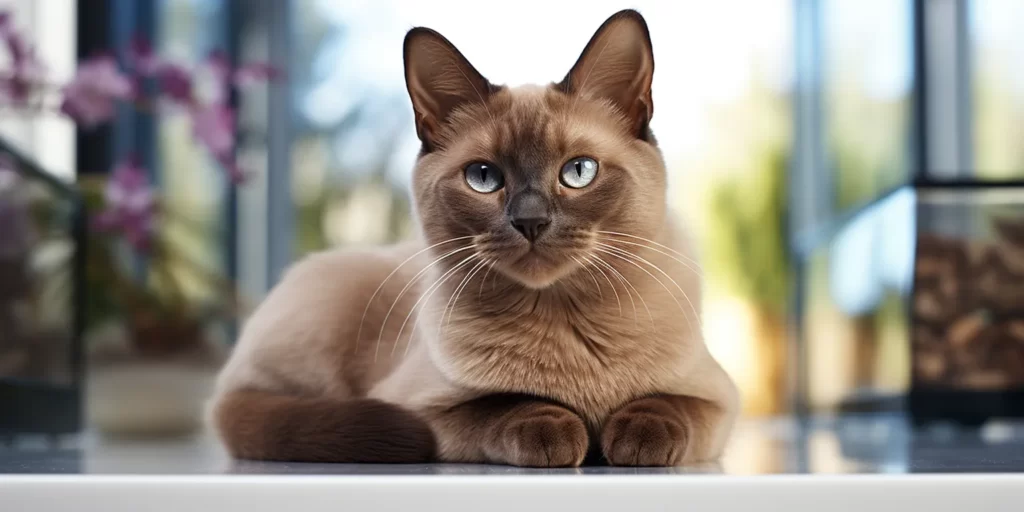You might wonder about the differences between male and female cats. With the Burmese breed, this curiosity is no different. This graceful, affectionate breed, known for its deep copper eyes and silky-smooth coat, offers unique characteristics depending on whether you opt for a male or a female.
Understanding the nuances of Male vs Female Burmese cats is essential in identifying the right pet for your household. So, let’s take a deep dive into what sets the males apart from the females and how these differences might influence your choice when it comes to welcoming a Burmese cat into your home.
The gender differences in Burmese cats is more than just physical aspects; it extends to their behavior, health, and even the way they interact with humans and other pets. So lets understand these differences.

Visual Differences
| Male Burmese Cat | Female Burmese Cat | |
|---|---|---|
| Average height (adult): | 9 – 13 inches | 9 – 13 inches |
| Average weight (adult): | 8 – 12 pounds | 7 – 10 pounds |
| Lifespan: | 18 – 25 years | 18 – 25 years |
| Activity Level: | High activity level | Moderate to high activity level |
| Grooming needs: | Low – weekly brushing | Low – weekly brushing |
| Family-friendly: | Very friendly | Very friendly |
| Other pet-friendly: | Usually good with socialization | Usually good with socialization |
| Trainability: | High – enjoys learning tricks | High – enjoys learning tricks |
Male Breed Overview
Male Burmese cats are known for their sociable and outgoing personalities. They tend to be the more extroverted of the sexes, often seeking attention and affection from their human companions.
Males typically grow to be larger than females, both in height and weight, giving them a more robust appearance.
This size difference, however, does not hamper their elegant gait and playful demeanor that the breed is known for. Male Burmese cats are muscular and strong, qualities that shine through in their active play and exploration.

Training A Male
Training a male Burmese can be a joyful experience due to their intelligent and eager-to-please nature. Though males may display more enthusiasm for interactive play which can be harnessed during training sessions.
Positive reinforcement techniques such as treats and praises work well with males, helping them learn tricks and commands quickly.
Health & Care
When we discuss Male vs Female Burmese health and care, it’s crucial to note that males are generally healthy but can be prone to certain hereditary conditions such as heart issues or diabetes. Regular vet check-ups are vital to maintaining their health.
Additionally, their coats, while short, do require routine grooming to keep it shiny and to reduce shedding; although, this is relatively minimal compared to other breeds.
Suitable for:
Male Burmese cats are well-suited for families and individuals alike. They thrive in environments where they can receive plenty of attention and engage in interactive play.
Those looking for an affectionate companion who is also playful will find the male Burmese to be an excellent choice.
Their adaptable nature makes them fit for various home settings, including those with children and other pets.

Female Breed Overview
Female Burmese cats are just as loving as their male counterparts but tend to display a more composed demeanor. They may be slightly smaller in size, which can be an advantage if you are looking for a cat that is a bit more manageable in terms of handling.
Females often exhibit strong maternal instincts and may seek out quiet time more frequently than males. While they enjoy company, they also value their independence.
Training A female
In terms of trainability, female Burmese cats match males with their intelligence and capacity to learn. They can be slightly more independent, which might require a touch more patience during training sessions.
However, their focused nature can actually be advantageous as they may be less likely to become distracted once engaged in the training process. Consistent training methods and an understanding approach will yield excellent results with females.
Health & Care
Health wise, female Burmese should be monitored for the same conditions as males. They should also maintain a regular veterinary schedule.
For females, especially if they are not spayed, pay close attention to their behavioral changes which could indicate health issues particularly related to their reproductive health.
Their grooming needs are identical to males — a simple weekly brushing will suffice due to their short coats.

Suitable for:
Female Burmese cats are ideal for those who appreciate a balance between an interactive pet and one that can entertain itself when needed. They make wonderful companions for single individuals or families with older children who understand the boundaries of pets.
They are adaptable but might prefer a slightly calmer environment compared to the boisterousness that could accompany a household of male cats or young children.
Which One Is Right for You?
Choosing between a Male vs Female Burmese cat ultimately comes down to personal preference and lifestyle. Males might be better suited for active households that can provide them with constant interaction and playtime. Females might be preferable if you desire a more independent cat who still cherishes moments of affection on her terms.

Conclusion
The differences between male vs female Burmese cats are subtle yet significant when contemplating which gender will best complement your lifestyle. Both sexes bring tremendous love, joy, and beauty into your home along with hallmark traits of intelligence and sociability unique to the breed.
Whether you choose a male or female Burmese cat, you’ll undoubtedly find a loyal and affectionate companion for years to come.
With either choice, you can look forward to the richly rewarding experience of sharing your life with one of these charming creatures.